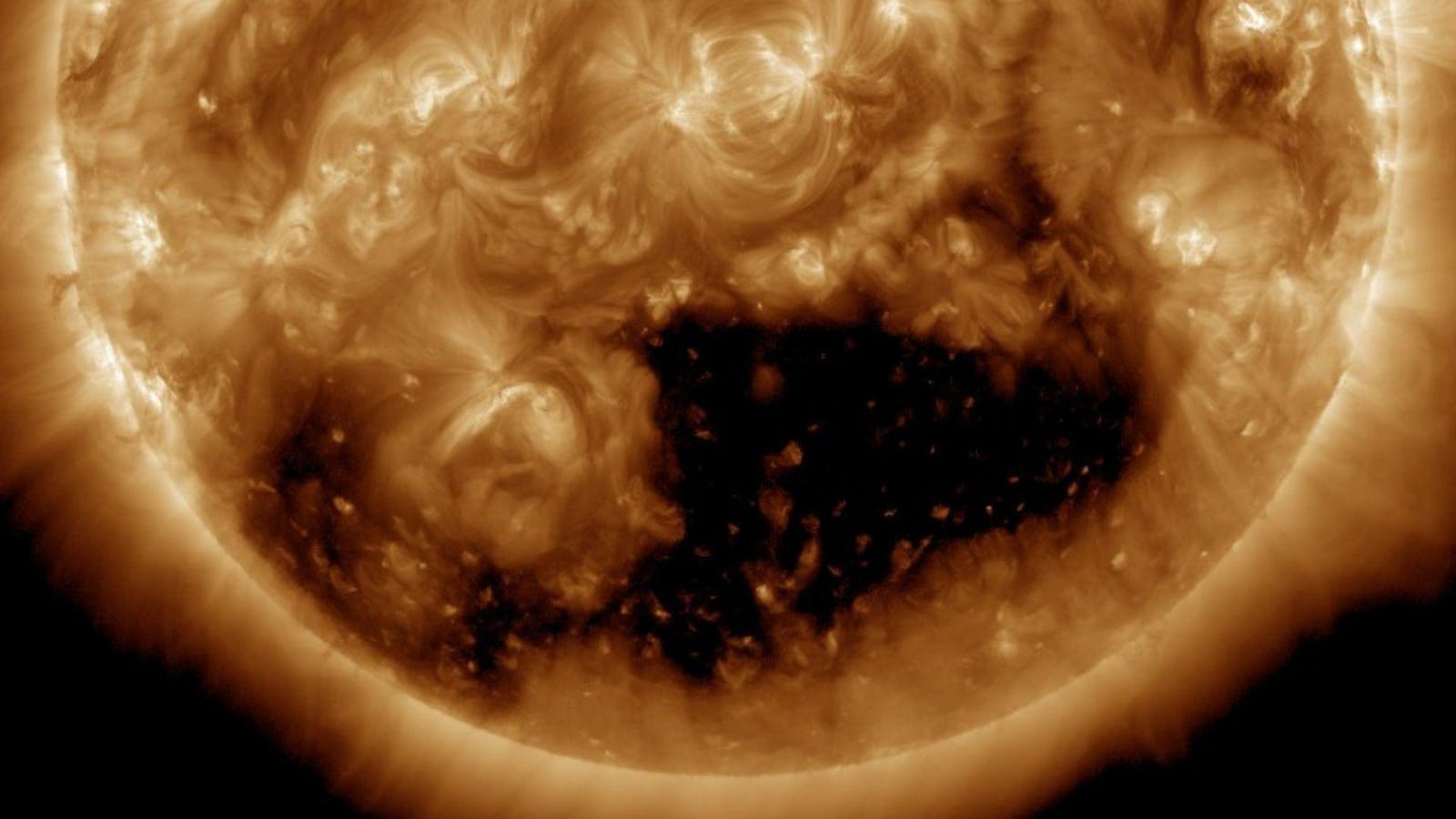Topline
The Northern Lights may be visible in the U.S. on Tuesday and Wednesday, April 22/23 due to a large hole opening up in the sun’s atmosphere. Visible to NASA’s Solar Dynamics Observatory spacecraft, the giant coronal hole measures about 600,000 miles (1 million kilometers); geomagnetic storms could be the result — causing displays of aurora in around 12 U.S. states.
An image of a coronal hole on the sun on April 21, 2025, as seen and imaged by NASA’s Solar Dynamics … More
Key Facts
Coronal holes appear as dark areas in the solar corona — the sun’s outer, hotter atmosphere — in extreme ultraviolet and X-ray images, according to the National Oceanic and Atmospheric Administration. They allow the solar wind (the stream of charged particles coming from the sun) to escape more easily into space.
Coronal holes mean a relatively fast solar wind, which can ultimately cause an intense geomagnetic storm and aurora on Earth when charged particles strike Earth’s magnetic field. They then accelerate down its magnetic field lines at the north and south poles to create ovals of green and red. The hole looks dark because the hot gas normally contained there is missing, according to Spaceweather.com.
The solar wind is on its way to Earth and is expected to arrive on Tuesday and/or Wednesday, April 22/23, according to NOAA, whose models are predicting a G2 geomagnetic storm overnight.
According to Moon Giant, the moon reaches its last quarter phase on Monday, April 21, meaning it will rise after midnight as a 35%-lit crescent in the early hours of Wednesday, April 23. These mostly moonless night skies will make it easier to see any faint aurora, but clear skies will also be required.
Where To See The Northern Lights Tonight
NOAA’s aurora view line prediction suggests that northern lights could be visible in up to 12 U.S. states, including Alaska, northeastern Washington, northern Idaho, Montana, North Dakota, South Dakota, Minnesota, northern Michigan, Wisconsin, Iowa, New York and Maine. Spaceweather.com recommends that sky-watchers “across Canada and northern-tier US states from New York to Washington should be alert for auroras.”
Northern Lights: What’s Causing This Alert
Big displays of aurora are typically associated with coronal mass ejections — a huge expulsion of plasma and magnetic field from the corona that can travel in the direction of Earth. However, the current instability in the solar wind is the result of a co-rotating interaction region — a transition zone in the solar wind that causes turbulence.
Aurora Borealis And ‘shooting Stars’
The prediction for potential northern lights comes the same week at the peak of the Lyrids meteor shower. Although it peaked on Monday-Tuesday night, some “shooting stars” are expected on Tuesday-Wednesday night. The Lyrids can produce occasional bright fireballs, streaks that can be visible for a few seconds in the night sky.
The Effect Of Solar Maximum
The sun’s magnetic activity intensifies during solar maximum, the peak of the sun’s 11-year solar cycle, which occurred in October 2024, according to scientists at NOAA and NASA. However, while the sun is now theoretically past the peak of its cycle, that doesn’t mean fewer displays of aurora. In fact, the declining phase can have very strong solar events. “This period of solar decline is marked by a decreasing number of sunspots, but not necessarily by fewer impacts, even after the solar maximum,” said Lisa Upton, co-chair of the Solar Cycle 25 Prediction Panel and lead scientist at the Southwest Research Institute, at the announcement in October.
Further Reading








